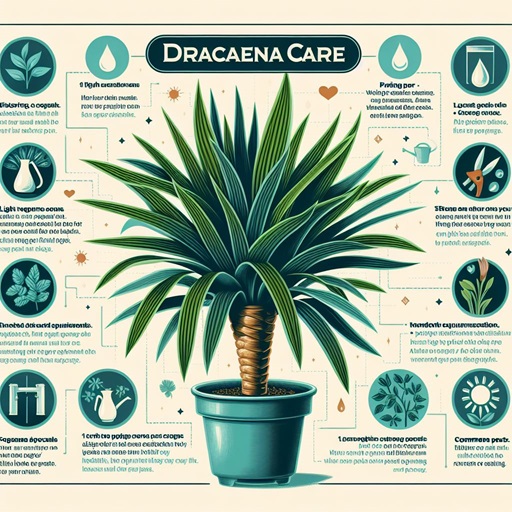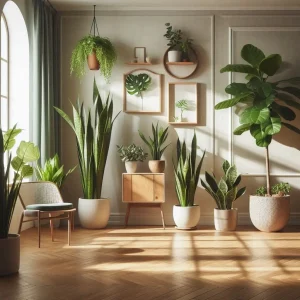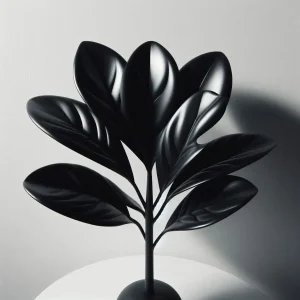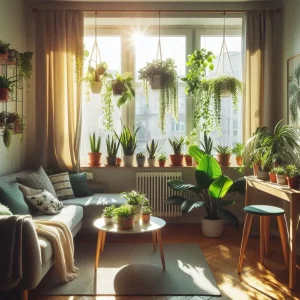| Care Tips | Description |
| Humidity | Maintain moderate humidity levels; spray the leaves in warm and dry air. |
| Temperature | Keep the plant at temperatures between 15-24 degrees Celsius. |
| Fertilization | Fertilize once every 2-3 weeks during the growing season with a liquid or complete fertilizer. |
| Soil | Use slightly acidic soil mixed with leaf mold and sand or perlite, or specialized potting soils. |
| Pot | Choose pots with multiple drainage holes; ceramic pots are suitable for compact Dracaena plants. |
| Troubleshooting | Address issues like pale leaves (indicating warm and dry air), yellowing leaves, and slow growth. |
| Toxicity | Dracaena plants are toxic; keep them away from children and pets. |
Dracaena plants have high resistance. However, for the well-being of any plant, factors such as light, watering, humidity, suitable soil, temperature, the amount and type of fertilization, pot replacement, or cleaning its leaves must all be observed. So if you want to become familiar with the conditions for caring for a Dracaena plant, stay with us.
Dracaena Care: Expert Tips & Troubleshooting
Page Contents
ToggleLight
Dracaena plants, as mentioned, are shade-loving plants, and you should protect them from direct sunlight. However, this plant grows faster in bright environments, and you should determine the exact proportion of light either experimentally or with the help of a consultant. But if you face challenges in providing light for the Dracaena plant, you can solve this problem by purchasing a plant growth lamp.
Watering Dracaena Plant
The Dracaena plant is sensitive to drought, so you should water it once a week in winter and two to three times a week in summer. To prevent the tips of its leaves from drying out, you should use cooled boiled water for watering.
Humidity
Indoor Dracaena plants require moderate humidity, so the room humidity is sufficient for them. We recommend that you occasionally spray the leaves in warm and dry air to help clean them from dust
Temperature
To care (maintain) the Dracaena plant, it should be kept at a temperature of 15-24 degrees Celsius. A decrease in temperature below 12 degrees Celsius can lead to leaf shedding and, consequently, the plant drying out. (Lowering the temperature to below 12 degrees Celsius will cause the leaves to fall and as a result the plant will dry up.) In temperatures above the plant’s tolerance level, you should spray water on the Dracaena plant’s leaves to prevent the burning of the leaf tips.
Fertilization
For better growth and the development (increase) of new leaves, it’s best to pay attention to your plant’s nutrition. You can fertilize the Dracaena plant once every 2-3 weeks during the growing season with a liquid fertilizer specially formulated for indoor plants or once a month with a complete fertilizer like 10-10-10 artificial fertilizer.
Of course, you can contact reputable global brands through Iran Growlight’s experts to buy liquid fertilizer and complete fertilizer to introduce suitable types of fertilizers for your indoor Dracaena plant.
Suitable Soil
This plant prefers (likes) slightly acidic soil. Therefore, you should mix potting soil or garden soil with leaf mold and sand or perlite, or use specialized potting soils that are well-draining. We recommend adding compost to enhance (strengthen) the soil for caring for the Dracaena plant.
Appropriate Pot
An appropriate pot should provide proper drainage for the soil. The first condition for choosing a suitable pot for the plant is to have multiple drainage holes at the bottom. Ceramic (Clay) pots are suitable for compact Dracaena plants because they allow the soil to dry between watering intervals and prevent it from drying out completely. If your Dracaena is small, you should get a pot with a size of 20 centimeters, and avoid pots with smaller dimensions.
Important Note in Dracaena Care
If you want to place the Dracaena plant in a tall container (a high growth), it’s better to trim its old stems to encourage better growth. Whenever you feel the plant’s growth has stalled, inspect it to ensure it’s not infested with pests.
Propagating Dracaena
In addition to using offshoots produced by the plant, you can propagate the Dracaena plant through stem cutting. In the first step, you should take cuttings from leafless stems and divide them into pieces of 5 to 7.5 centimeters. Dip each cutting into rooting hormone powder or gel and place them in a plastic bag at a temperature of 24 degrees Celsius, away from direct sunlight. After two months, remove the bag and start artificial feeding.
Diseases and Treatments of Dracaena Plants
Diseases and pests of Dracaena plants are the same in their various types, which we will discuss in the following section, addressing their treatment methods.
If you notice pale leaves and excessive leaf shedding, it indicates warm and dry air. You should move the plant to a cooler environment and spray it with water three times a week in summer. Additionally, you can seek advice from a plant specialist.
If you see yellowing leaves on your Dracaena plant and notice spider webs underneath them, the cause is likely red spider mites. To protect the Dracaena plant from these mites, you should treat it with a miticide every two weeks. Increasing your greenhouse equipment can help improve this issue.
If the new leaves are small and the plant’s growth rate has significantly decreased, it indicates that the soil lacks nutrients. It’s better to nourish the plant with suitable fertilizer or consider purchasing new soil. Yellowing of the lower leaf margins and browning of the tips of the Dracaena indicate that it needs watering. Place the pot in a tray (pan) filled with water for 15 minutes and then adjust its watering.
Is Dracaena Plant Poisonous?
Yes, the Dracaena plant is toxic, and if ingested by children or pets, it can cause poisoning. The symptoms of ingesting Dracaena for cats and dogs include vomiting, nausea, weight loss, dilated pupils, and diarrhea. You should keep the indoor Dracaena plant away from your pets.
If you want to learn more about non-toxic indoor plants for dogs, be sure to check out article indoor plants safe for dogs.
Types of Dracaena
As we mentioned, Dracaena is a plant with high diversity, but only a few types are commercially grown and sold on a large scale. Although caring for all types of Dracaena is easy, each has its own unique characteristics.
Here, we’ll introduce you to 6 species of this plant:
Lemon Lime Dracaena
The Lemon Lime Dracaena with its green and yellow leaves has a very beautiful and unique appearance. Additionally, caring for the Lemon Lime Dracaena is as easy as its other relatives and is considered a suitable option for today’s world. This plant can grow up to about 2 meters indoors, provided that its maintenance conditions are ideal. However, if you don’t want it to grow too much for any reason, you can keep its size small by trimming it regularly.
Occasionally rotate the Lemon Lime Dracaena to ensure more efficient and effective photosynthesis. This will also improve the plant’s growth.
Marginata Dracaena
The Marginata Dracaena is another member of the Dracaena family known as an indoor plant. This plant grows like a small palm tree to a height of about 2 meters and has upright, slender, woody stems with green and narrow leaves.
Fragrans Dracaena
Another popular type of Dracaena is Fragrans Dracaena. This plant has wide and colorful leaves that reach a height of 60 and a width of 8 centimeters. If you look at the leaves of Fragrans Dracaena, you will clearly see the variety of green and yellow lines. Just take care of this plant a little to see its beautiful and captivating leaves. If you take good care of it and are (be) a little lucky, you can look forward to the small white flowers blooming!
When caring for Fragrans Dracaena, keep in mind that this plant needs to be somewhat dry; so after giving it enough water, wait for the soil surface to dry completely before watering it again. Fragrans Dracaena loves moisture, so try to keep its environment moist all the time. Note that the browning of the leaves of this plant indicates a lack of humidity.
Reflexa Dracaena (Indian Rubber Plant)
Reflexa Dracaena has a neater appearance compared to Marginata Dracaena. The green leaves of this plant are curved and round and are beautifully decorated with yellow stripes. Reflexa grows between 90 to 120 centimeters and is considered an exceptionally beautiful indoor plant.
Dracaena Compacta
The Dracaena Compacta plant originally belongs to Southeast Africa. The beautiful and delicate leaves of the plant and their unique shape have transformed Dracaena Compacta into a very beautiful indoor plant. The growth of Dracaena Compacta is very slow, so if you’re looking for a plant that won’t grow too much after purchase, Dracaena Compacta will definitely be a very suitable choice for you.
Dracaena Tarzan
The Dracaena Tarzan plant was first discovered in the state of Florida, USA, and later became popular worldwide due to its beautiful appearance. This type of Dracaena has thick leaves, and sometimes traces of pink color can be seen on them.
Reasons for the leaves of Dracaena turning brown:
| Reason for Browning Leaves | Symptoms | Treatment |
| Inconsistent watering | Brown tips or spots on leaves | Check soil moisture regularly and water appropriately every 7-10 days. Avoid letting soil dry out completely. |
| Sensitivity to water quality | Brown spots on leaf tips and edges | Allow tap water to sit for 24 hours to allow chlorine and fluoride to evaporate. Use boiled, distilled, or rainwater if white deposits are observed on the pot’s surface. |
| Leaf spot disease | Brown spots with yellow margins | Separate diseased leaves, isolate the plant, and spray with a mixture of sweet milk and mineral oil (2 tablespoons each). Shake the mixture well before use. |
During the care of a Dracaena plant, brown spots may appear on the leaves for various reasons, but most of the time, improper watering is the main cause. Before delving into (knowing about) the reasons, it’s important to understand what is meant by “browning” of the leaves. The browning of Dracaena leaves can manifest in one of three ways:
- Browning and dryness on some leaves
- Browning of leaf tips
- Small brown spots surrounded by yellow margins
Inconsistent (Discontinuous) watering
Inconsistent (Discontinuous) watering is one of the reasons for browning leaves during Dracaena care. If you notice brown tips on Dracaena leaves or the appearance of brown spots, it’s highly likely due to inconsistent (Discontinuous) watering. This can lead to excessive dryness, and if the soil becomes too dry, the leaf tips can brown, and various spots will appear on its surface.
Treatment:
The best way to determine the correct watering time is by checking the soil’s moisture level. To do this, dig a few centimeters into the soil and check its moisture. If it’s dry, it’s better to water the plant. This should be done every 7-10 days, and it’s important not to let too much time pass between waterings. This is especially crucial during the summer when indoor environments tend to be warmer and drier (because usually the indoor environment of houses is hot and dry in winter and its soil dries up sooner).
Sensitivity to water quality
If you notice brown spots on the leaf tips and edges, your plant may be having issues with water quality. The presence of chlorine or fluoride in tap water, or the accumulation of salts in the soil, can cause these symptoms.
Treatment:
Use a suitable container and pour tap water into it. Allow it to sit without a lid for at least 24 hours. This allows chlorine and fluoride present in the water to evaporate, making the water more ideal for the plant. If you observe the accumulation of white deposits on the surface of the pot (especially near drainage holes), it indicates excess salt, so it’s better to use boiled, distilled, or rainwater instead of water that has been rested for 24 hours. This way, the plant will be healthier, and any excess salts will be flushed out.
Leaf spot disease
If you notice brown spots surrounded by yellow margins on the surface of Dracaena leaves, your plant may be suffering from leaf spot disease. Fungal and bacterial attacks on the plant can cause brown spots along with yellow edges. These yellow edges serve as the feeding ground for these microorganisms. These spots are not unique in shape and can vary in appearance, size, and color.
Treatment:
Immediately separate the diseased leaves from the plant and isolate it from other plants. Spray the homemade solution to all parts of the plant with brown spots. Mix two tablespoons of sweet milk (baking soda) with two tablespoons of mineral oil. Remember to shake this mixture well before use.
Reasons for the leaves of Dracaena turning yellow:
And now, the reasons for yellowing leaves in Dracaena:
| Reason for Leaf Yellowing | Description |
| Lack of sufficient space for root growth | Over time, root growth becomes congested, leading to leaf yellowing. Adequate air circulation is essential for addressing this issue. Transferring the plant to a larger pot with well-draining soil can help. |
| Overwatering | Excessive watering is the most common reason for leaf yellowing. Dracaena plants cannot tolerate excessive moisture, leading to leaf yellowing. Check the soil moisture and allow it to dry completely before watering again. |
| Lack of essential nutrients | Nutrient deficiency, such as nitrogen deficiency, can cause leaf yellowing. If environmental conditions are suitable but the leaves turn yellow, consider using a fertilizer high in nitrogen. |
| Cold water temperature | Watering the plant with cold water can shock it, resulting in leaf yellowing. Ensure that the water temperature is slightly warmer than the ambient temperature to avoid this issue. |
| Dry air | Excessive dryness in the air can cause leaf yellowing in Dracaena plants. Increase humidity levels around the plant by avoiding placement near heating/cooling devices and by regularly misting the plant. |
| Proximity to a heat source or cold | Placing Dracaena near heat sources or in drafty areas can lead to leaf yellowing and plant decline. Avoid sudden temperature changes and extreme conditions to prevent harm to the plant. |
Lack of sufficient space for root growth
Over time, root growth becomes congested. If adequate air circulation is not provided, the plant will experience various problems, including leaf yellowing. In this case, to address the issue of leaf yellowing, transfer it to a larger pot and choose well-draining soil.
Overwatering as one of the reasons for leaf yellowing during Dracaena care
This is the most common reason for leaf yellowing during Dracaena care. The plant cannot adapt to excessive watering, so this issue will manifest through leaf yellowing. To confirm that your plant’s leaves have turned yellow due to overwatering, check the roots. If the soil around them is wet and muddy, allow it to dry completely before watering again.
Lack of essential nutrients
Sometimes, leaf yellowing in Dracaena is due to nutrient deficiency. Nitrogen deficiency can cause leaf yellowing. If environmental conditions are optimal for the plant but its leaves turn yellow, consider this possibility. In this case, use a fertilizer with high nitrogen content.
Cold water temperature
Another reason for leaf yellowing in Dracaena care is watering the plant with cold water. Watering Dracaena with cold water shocks it. Therefore, if you have watered your Dracaena with cold water, leaf yellowing may be the result of this shock. To avoid this problem, remember that the water temperature should always be a few degrees warmer than the ambient temperature.
Dry air as a cause of leaf yellowing in Dracaena
Excessive dryness in the air can almost always cause the leaves of any plant to turn yellow, and Dracaena is no exception to this rule. As mentioned, Dracaena is a tropical plant and is accustomed to living in humid environments. Therefore, it is necessary to increase the humidity of the air around it. To do this, do not place it near heating/cooling devices and try to provide sufficient moisture by spraying water around it.
Proximity to a heat source or cold
Dracaena should not be placed next to a radiator, fireplace, cooler (air conditioner), or open window, as placing it in these positions can cause leaf yellowing and the demise of the plant. Sudden temperature changes or placing it in a threshold state can be detrimental to the plant, and generally, any drastic or excessive change in any case will harm the plants.
Why does Dracaena shed its leaves?
The third issue you may encounter in caring for Dracaena is leaf shedding. Leaf shedding serves as a warning to you, but there’s no need to worry; sometimes, shedding is a natural part of the plant’s life cycle. Like other plants, Dracaena sheds its old leaves to facilitate fuller growth. So, if your plant is losing long-standing leaves, it’s just a healthy, personal grooming action for the plant, and there’s no cause for concern. However, if a significant number of leaves suddenly fall, the situation is different. This usually happens when there has been a lapse on your part. The first possibility is under or over-watering, and the next reason is attributed to drastic temperature changes, which we’ll explain further in detail.
The third issue you may encounter in caring for Dracaena is leaf shedding. Leaf shedding serves as a warning to you, but there’s no need to worry; sometimes, shedding is a natural part of the plant’s life cycle. Like other plants, Dracaena sheds its old leaves to facilitate fuller growth. So, if your plant is losing long-standing leaves, it’s just a healthy, personal grooming action for the plant, and there’s no cause for concern. However, if a significant number of leaves suddenly fall, the situation is different. This usually happens when there has been a lapse on your part. The first possibility is under or over-watering, and the next reason is attributed to drastic temperature changes, which we’ll explain further in detail
| Issue | Description |
| Overwatering | Excessive watering can lead to soggy soil, root rot, and shedding leaves. Ensure proper drainage and avoid leaving the plant sitting in water. |
| Underwatering | Insufficient watering can cause dry roots and leaf shedding. Check the soil moisture regularly and water the plant when the soil feels dry to the touch. |
| Drastic Temperature Changes | Sudden shifts in temperature, such as exposure to cold drafts or excessive heat, can result in leaf shedding. Keep the plant in an environment with stable temperatures. |
Overwatering
Usually, when you first notice the shedding leaves, you rush to water the plant without realizing that this excess water is the cause of the issue. As mentioned in the earlier sections of caring for Dracaena, it cannot tolerate soggy soil, and shedding leaves indicate this problem. Moreover, such soil provides a breeding ground for various fungal diseases and root rot.
Dracaena should be planted in pots with multiple drainage holes, and after each watering, excess water should be emptied from the pot to prevent waterlogging. To ensure the water level, it’s better to remove the plant from the pot. If the roots appear rotten and the soil is wet, overwatering is the cause of leaf shedding. To solve the problem, separate the damaged parts from the root and replant the plant in fresh soil.
Underwatering(Insufficient watering)
Sometimes, insufficient watering can also lead to leaf shedding in Dracaena. To check for this, simply touch the bottom part of the potting soil; if it’s dry, it means the roots are dry and the Dracaena needs watering.
Drastic Temperature Changes
Extreme cold winds or excessive heat can also cause Dracaena leaves to shed. If your indoor environment has such conditions and the leaves of your Dracaena are falling, drastic temperature changes are the cause. To address this issue, move the plant to an area with a relatively stable temperature.
After introducing the potential problems, one of the most important things to know is the correct method of separating the leaves or affected parts of the plant so that no further issues arise during the care and treatment of Dracaena.
Proper Method of Separating Leaves or Diseased Parts of a Plant
We always recommend that before any problem escalates, you separate the leaves or diseased parts of the plant. By doing this, you will help the plant have enough energy to heal itself and appear healthy. To do this, you should cut off the tips of the leaves or other brown or yellowed areas of the plant with a sterilized pair of scissors. Be careful to only trim the brown part and avoid causing any damage to the healthy sections of the plant. For this purpose, it’s better to leave a very thin strip of the brown/yellow part on the leaf and not separate it from the rest. But if the entire surface of the leaf is brown or yellow, remove it from the base. This is not difficult to do, as the leaf usually breaks off easily; however, if the leaf does not separate from the plant when pulled firmly, use a sharp, sterilized pair of scissors to cut it from the stem.
In this article, we have tried to explain everything you need to know about the care method of Dracaena plants, introducing different types of Dracaena, and their potential problems at home or in the workplace. If there’s anything left unsaid or if you have any questions that require specialized consultation about your plant, you can use the plant consultation service provided by Gulistan Plants. Our experienced plant specialists are ready to answer your questions. Plant doctors will examine your problem and, if necessary, send you plant food (fertilizer), pesticides, and other plant essentials. Also, if you don’t have enough time or expertise to take care of your plant, you can use the home gardening services provided by Gulistan Plants in Tehran (sending a gardener and plant doctor to your location) so that our experts can come to your place with the necessary tools and provide services such as disease diagnosis, reasons for lack of growth, soil and pot replacement, pesticide spraying, fertilization, or even planting, and more.







